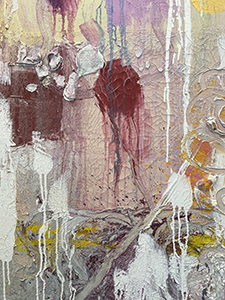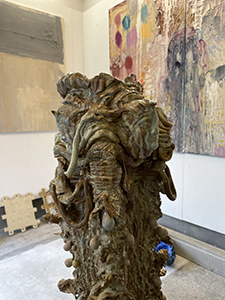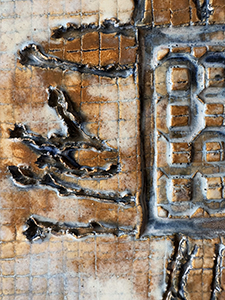
Innerfaces – Walking through the Maze
Innerfaces – der Gang durch den Irrgarten
Personal exhibition
Opening Sat 06 May 2023 at 17:00h
Sat 06 May - Sun 21 May 2023
Opening hours: Thu/Fri 16:00h-18:00h, Sat/Sun 14:00h-17:00h
Waschhaus of Villa Grunholzer, Uster (in the garden of the villa)
Clay in its different stages, from raw to becoming a ceramic body, is my primary material for this exhibition project. I experiment with the performative character of experience embodied in clay.
Innerfaces – Walking through the Maze, personal exhibition by Dimitrina Sevova, Waschhaus of Villa Grunholzer, Uster. Exhibition views. Photos courtesy of the artist
Preview of works for Innerfaces – Walking through the Maze, personal exhibition by Dimitrina Sevova, Waschhaus of Villa Grunholzer, Uster. Photos courtesy of the artist
“Everything begins by the apparition of a specter.” – Jacques Derrida
The exhibition project’s starting point is Walter Benjamin’s psychogeographic practices of the urban flâneur “botanising on the asphalt,” which for me is a metaphor for the poetic surface of the inorganic and the natural world that mutually entangle, unfolding a pattern. Walking and exploring the surroundings, I collected traces, giving the material a direct sense and context. The flâneur is a rather male figure, an intellectual dandy whose urban strolls takes him downtown. In my project, I appropriate it as a female roaming the suburban environment of Zurich using clay to document my encounter with found objects instead of a notebook or camera. I ask myself how a ball of clay can be thrown into daily life.
The exhibition evokes the image of history and myths as mental states, which appear in a moment of present danger, in an ecology of practice walking with wonder through their maze. The clay pieces, pressed and affected by gravity, form a constellation of amorphic fragments, variations cut in the smallest detail, carrying over techniques of montage which are not only a cinematic but also a sculptural method. The fragments, found and abstracted like the re-collection of a broken vessel glued back together, rather make for a new creation connecting disjointed parts in new correspondences through play.
Timespace coordinates. 81 years after On the Concept of History, a screen image of a chess board. Artificial Intelligence algorithms for human play have been perfected, and today’s chess engines will not drop a game to human players. From AlphaZero in 2017, trained 24 hours with generic reinforcement to achieve a superhuman level of play, and Leela Chess Zero in 2018, to Maia in 2020, which sympathizes with human error to play out different personalities, as it plays superhuman chess in a human way and might bring back the pleasure of the game. Let us not forget that behind every engine, there is a team of programmers, engineers, and chess experts. Human knowledge is accumulated by machines who learn from each other, speak to each other a language that we humans do not understand. Through prosthetics, human biological cognition and computer digital data create a completely different operational system. Artificial Intelligence in the future perhaps would be directly implemented into the human brain. One can envision a corresponding object to this apparatus in philosophy and in art. – Dimitrina Sevova (2022)
It is well-known that an automaton once existed, which was so constructed that it could counter any move of a chess-player with a counter-move, and thereby assure itself of victory in the match. A puppet in Turkish attire, water-pipe in mouth, sat before the chessboard, which rested on a broad table. Through a system of mirrors, the illusion was created that this table was transparent from all sides. In truth, a hunchbacked dwarf who was a master chess-player sat inside, controlling the hands of the puppet with strings. One can envision a corresponding object to this apparatus in philosophy. The puppet called “historical materialism” is always supposed to win. It can do this with no further ado against any opponent, so long as it employs the services of theology, which as everyone knows is small and ugly and must be kept out of sight. – Walter Benjamin, On the Concept of History (1940)
Documentation of the installation on Instagram.
Dokumentation der Installation auf Instagram.





























